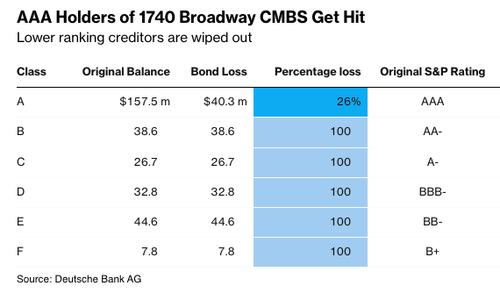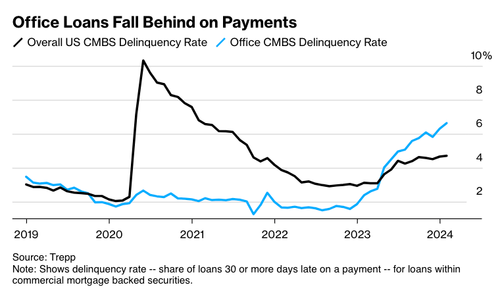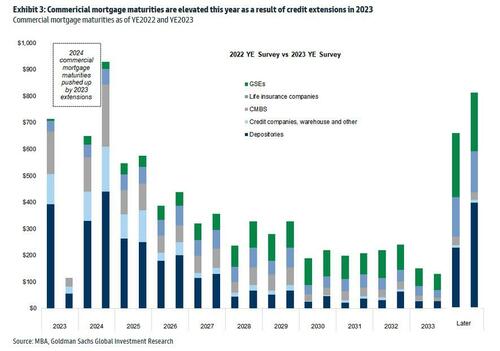
Investors holding a tranche of top-rated debt backed by commercial real estate have suffered losses for the first time since the housing meltdown collapsed the economy 16 years ago. This alarming development signals a worsening multi-year downturn in the CRE space, fueled by the Federal Reserve's interest rate hiking cycle and plummeting office tower values nationwide.
Bloomberg first reported that CMBS strategists at Barclays pointed out that buyers of the AAA portion of a $308 million note backed by the mortgage on the 1740 Broadway building in midtown Manhattan received less than three-quarters of their initial investment in recent weeks after the loan was dumped at a sizeable discount. All low-tier creditors were wiped out.

"Now that we've seen the first commercial mortgage-backed securities get hit, other AAA bonds are bound to see losses," Lea Overby, a CMBS strategist at Barclays, wrote in a note, adding, "These losses may be a sign that the commercial real estate market is starting to hit rock bottom."
"With about $700 billion of non-agency CMBS outstanding and another $3 trillion of commercial mortgages on bank balance sheets, even a modest uptick in losses could weigh on the financial system for years," Bloomberg journos said. They were quick to note, "To be clear, no one is predicting a repeat of 2008, when bad mortgages, mostly residential, nearly brought down the financial system."
On Wednesday, the latest FOMC minutes showed a "deterioration in conditions in domestic CRE markets or a sharp tightening in financial conditions."
Recent data from Moody's Ratings showed the share of delinquent office packaged into CMBS topped 6.4% in April, the highest level since June 2018.
What's troubling is that $52 billion, or 31%, of all office loans in CMBS, were in dire straits in March. That's up 16% from a year ago, according to KBRA Analytics. The firm said some cities are facing more stress than others, including Chicago and Detroit.
Here is the latest data from real estate firm Trepp: Owners are quickly falling behind on office loan payments.

Across the entire CRE space, a $1 trillion debt maturity wall is due later this year.
Mortgage Bankers Association notes that $929 billion—20% of the $4.7 trillion total—in commercial mortgages held by lenders and investors are coming due this year. The figure is up 28% from 2023 and inflated by amendments and extensions from prior years. Nevertheless, borrowers are now having to bite the bullet and pay up or default.
It's extremely rare for AAA-rated tranches to take a hit, making the situation on the 1740 Broadway building an eye-opener for more CMBS debt with a high concentration of single-office loans to experience losses. The CRE storm is far from over.
Investors holding a tranche of top-rated debt backed by commercial real estate have suffered losses for the first time since the housing meltdown collapsed the economy 16 years ago. This alarming development signals a worsening multi-year downturn in the CRE space, fueled by the Federal Reserve’s interest rate hiking cycle and plummeting office tower values nationwide.
Bloomberg first reported that CMBS strategists at Barclays pointed out that buyers of the AAA portion of a $308 million note backed by the mortgage on the 1740 Broadway building in midtown Manhattan received less than three-quarters of their initial investment in recent weeks after the loan was dumped at a sizeable discount. All low-tier creditors were wiped out.

“Now that we’ve seen the first commercial mortgage-backed securities get hit, other AAA bonds are bound to see losses,” Lea Overby, a CMBS strategist at Barclays, wrote in a note, adding, “These losses may be a sign that the commercial real estate market is starting to hit rock bottom.”
“With about $700 billion of non-agency CMBS outstanding and another $3 trillion of commercial mortgages on bank balance sheets, even a modest uptick in losses could weigh on the financial system for years,” Bloomberg journos said. They were quick to note, “To be clear, no one is predicting a repeat of 2008, when bad mortgages, mostly residential, nearly brought down the financial system.”
On Wednesday, the latest FOMC minutes showed a “deterioration in conditions in domestic CRE markets or a sharp tightening in financial conditions.”
Recent data from Moody’s Ratings showed the share of delinquent office packaged into CMBS topped 6.4% in April, the highest level since June 2018.
What’s troubling is that $52 billion, or 31%, of all office loans in CMBS, were in dire straits in March. That’s up 16% from a year ago, according to KBRA Analytics. The firm said some cities are facing more stress than others, including Chicago and Detroit.
Here is the latest data from real estate firm Trepp: Owners are quickly falling behind on office loan payments.

Across the entire CRE space, a $1 trillion debt maturity wall is due later this year.
Mortgage Bankers Association notes that $929 billion—20% of the $4.7 trillion total—in commercial mortgages held by lenders and investors are coming due this year. The figure is up 28% from 2023 and inflated by amendments and extensions from prior years. Nevertheless, borrowers are now having to bite the bullet and pay up or default.
It’s extremely rare for AAA-rated tranches to take a hit, making the situation on the 1740 Broadway building an eye-opener for more CMBS debt with a high concentration of single-office loans to experience losses. The CRE storm is far from over.
Loading…







